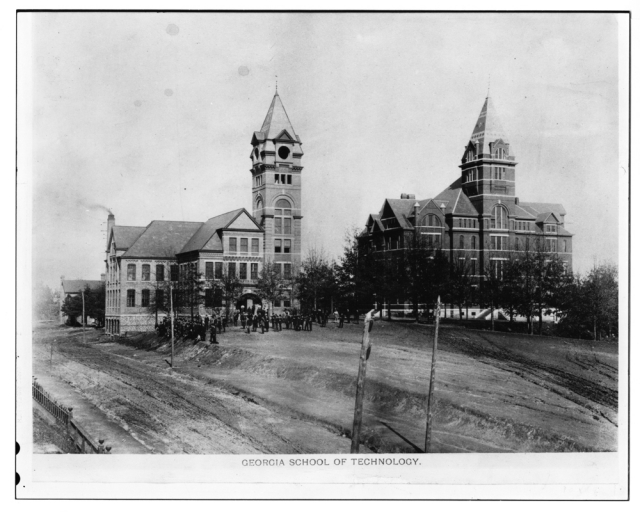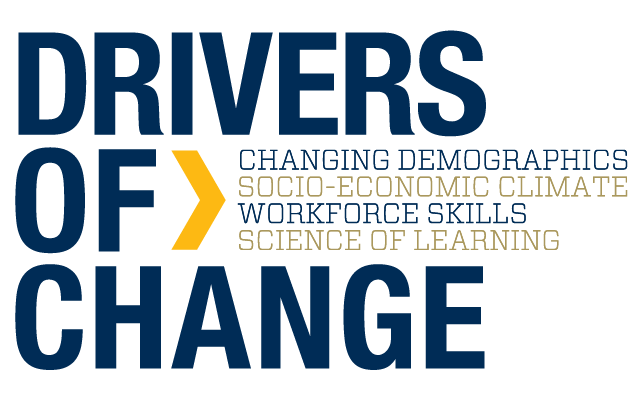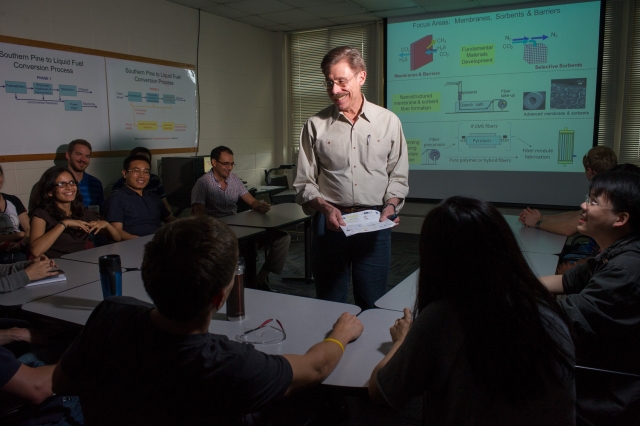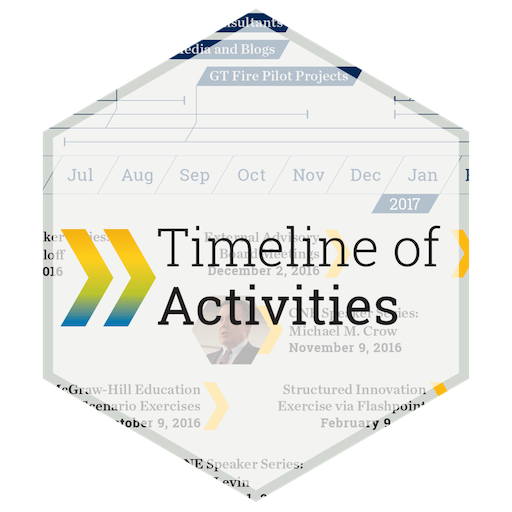This moment is ripe for change in higher education. Scores of technology entrepreneurs, foundations, and policymakers are already trying to shape what the future will look like for both learners and institutions. The message for colleges and universities is clear: they can either sit idly by or join in to design their own destiny.
As a selective public institution with a history of educational innovation, the Georgia Institute of Technology (Georgia Tech) sits squarely in the middle of the forces shaping higher education. It is uniquely positioned to model what the university of the future might look like.
This report of the Georgia Tech Commission on Creating the Next in Education (CNE) is an effort to draw with broad strokes the nature of education that defines the technological research university of the year 2040 and beyond. The Commission was formed because many within the institution are convinced that by the second half of this century Georgia Tech will be different from the university that matured and prospered in the nineteenth and twentieth centuries. Georgia Tech’s mission seems to demand that the Institute examine the choices that lie ahead and make plans for a future that, however uncertain, is bound to present opportunities and challenges that cannot be understood as incremental changes in the status quo.
 In a prior report titled Discovering the Drivers of Change in Higher Education (Georgia Tech 2016), the Commission outlined the forces likely to affect Georgia Tech, including a new and accelerating revolution characterized by technology-driven disruptive change throughout society, shifting public attitudes about the role of public universities, and demographic trends that challenge long-held assumptions about who will benefit from a college education. Upon publication of that report, the Commission engaged in a broad search for ideas about how best to anticipate the kinds of changes that are certainly in store for Georgia Tech and to synthesize a roadmap for the future.
In a prior report titled Discovering the Drivers of Change in Higher Education (Georgia Tech 2016), the Commission outlined the forces likely to affect Georgia Tech, including a new and accelerating revolution characterized by technology-driven disruptive change throughout society, shifting public attitudes about the role of public universities, and demographic trends that challenge long-held assumptions about who will benefit from a college education. Upon publication of that report, the Commission engaged in a broad search for ideas about how best to anticipate the kinds of changes that are certainly in store for Georgia Tech and to synthesize a roadmap for the future.
The Commission was launched in late 2015 to explore ideas, plans, and ecosystems and, above all, to articulate a vision that will position Georgia Tech to respond to these forces and to recommend ways to move toward this vision. The Commission’s charter is a declaration of aspirations. It is not intended as a strategic plan, but to inspire a future generation of leaders. It is not without precedent in the 130-year history of Georgia Tech. After all, when the Institute was founded in 1885, it was at the intersection of great nineteenth century movements in American higher education.
Swirling social, political, and economic forces of the post-reconstruction era almost derailed the vision of a new public university that would boost the aspirations of a region in danger of being left behind by the industrial revolution sweeping the rest of the nation. At issue was how to prepare the citizens of a poor, rural state for this new world. Would the new Georgia School of Technology be a narrow institution, designed to enable students to acquire basic skills—catering to public sentiment that favored a workforce armed with practical, technical knowledge—or would it strive to be a polytechnic in the tradition of Europe and the industrialized Northeast?

The debate was whether it was better and more economical to train the people who greased the machines of the modern age or to educate the people who created them. As at Williams College decades before, much of this debate centered on whether it was within the capabilities of rough-hewn farmers and laborers to master complex material.
For Isaac Hopkins, the preacher and engineer tapped to be Georgia Tech’s first president, the answer was simple. According to Hopkins, the movement toward industrial education was, "one of those great revolutions of thought and public sentiment, the results of which are not for a day or a generation, but for all time," (McMath et al. 1985, p. 22). Georgia Tech was to be founded on a new idea—the need to understand the complexities facing the modern industrial age rather than the simple tools of a prior generation.
Hopkins declared, “[s]killed labor of today requires thinking.” (McMath et al. 1985, p. 22) Georgia Tech rose to prominence as an elite research university on such aspirations; its founders looked out a century and made plans for that future. This attitude toward the future is so important that it has become the central value in the Institute’s vision: to define the technological research university of the twenty-first century.
 Once again great revolutions are roiling industry and commerce, but this time they are global, with accelerating socioeconomic effects. Despite this, many voices demand that higher education focus on the skills needed for the current workplace. After decades of sustained growth, the number of high school students entering college is in decline. Students arrive with lower levels of achievement and greater financial need than at any time in memory. The public investment in colleges and universities lags other demands, causing political leaders to search for a more focused and cost-effective means of education.
Once again great revolutions are roiling industry and commerce, but this time they are global, with accelerating socioeconomic effects. Despite this, many voices demand that higher education focus on the skills needed for the current workplace. After decades of sustained growth, the number of high school students entering college is in decline. Students arrive with lower levels of achievement and greater financial need than at any time in memory. The public investment in colleges and universities lags other demands, causing political leaders to search for a more focused and cost-effective means of education.
The Georgia Tech of 2018 sits squarely in the middle of these forces. It is, for example, a rare public institution that has become increasingly selective. Not only are entering students better prepared than their peers at other institutions, they are better prepared than previous Georgia Tech students, even as they become less representative of an economically and ethnically diverse population. Georgia Tech students learn skills that are in demand by today’s employers, but the price of acquiring these skills has nearly tripled since 2006.
In short, Georgia Tech has not been immune to the disruptive forces facing the rest of higher education, and the changing landscape of a Georgia Tech education is apparent to anyone who looks at the numbers. The Institute can hold fast to a course that was set long ago, or it can anticipate the kind of landscape that is being carved out for all educational institutions. This is a critical juncture in Georgia Tech’s history and it is essential to ask, as did President Hopkins, whether the assumptions of past generations will be a solid basis for the future—not for the next decade, but for 2040 and beyond.
The Bedrock Values of Georgia Tech
Remain a Research University: Georgia Tech will remain a research university with the resources and capabilities to pursue the creation of knowledge at the frontiers of science and technology. This guiding aspiration often sets the Institute apart from other universities and colleges that seek to redefine their educational missions.
Preserve a Public Mission: State and federal funds being shifted away from educational programs have pushed public and land-grant universities toward business models that are less dependent on sustaining funds from states—models more like those of private universities. But Georgia Tech will retain its commitment to public education. The Institute will hold fast to those values that have been successful in helping to build modern society. This includes redefining the social contract that binds the fate of society to its colleges and universities and includes renewing a commitment to access, affordability, and excellence, the historic calling of public postsecondary education.
Georgia Tech Values
- Remain a Research University
- Preserve a Public Mission
- Celebrate an Inclusive, Diverse Community and Culture
- Continue to Focus on Science and Technology
- Promote and Value the Residential Experience
Celebrate an Inclusive, Diverse Community and Culture: Like most public institutions, the Institute inherits a commitment to inclusiveness and diversity in academic and non-academic communities. As a technological research university, Georgia Tech recognizes that gender, ethnic, and socioeconomic diversity in the scientific and technical fields is essential and actively promotes a culture of inclusiveness that expands diversity.
Continue to Focus on Science and Technology: The Georgia Tech mission statement commits the Institute to a pathway that values its role in defining a technological research university. The Institute may continue to offer broad courses of study, oftentimes by reinventing educational experiences in fields once thought to be removed from STEM disciplines in both content and culture. Even in those instances, the Institute’s focus on science, mathematics, computing, and engineering as lenses for examining critical problems will remain the primary tool for describing and understanding the world.
 Promote and Value the Residential Experience: Changes to the Institute’s educational mission might involve expansion beyond the typical 18- to 24-year- old undergraduate and the discipline-focused graduate students upon which Georgia Tech’s academic reputation was built. None of these changes diminish the Institute’s ability to conduct residential educational programs at the highest level. Programs, products, and services studied by the Commission expand upon these traditional educational experiences, even though the numbers of students enrolled in non-residential programs may rise dramatically.
Promote and Value the Residential Experience: Changes to the Institute’s educational mission might involve expansion beyond the typical 18- to 24-year- old undergraduate and the discipline-focused graduate students upon which Georgia Tech’s academic reputation was built. None of these changes diminish the Institute’s ability to conduct residential educational programs at the highest level. Programs, products, and services studied by the Commission expand upon these traditional educational experiences, even though the numbers of students enrolled in non-residential programs may rise dramatically.
These values anchored much of the Commission’s work. The vision for the future described in this report remains centered on Georgia Tech’s commitment to the highest caliber of research and education that improve the lives of the people of the state, the nation, and the world. Above all, the findings of the Commission represent an aspirational commitment to Georgia Tech’s long-term and personalized investment in the Institute’s students and all the citizens of the state of Georgia.
The Commission's Charge and Work
With this commitment in mind, the Commission was formed in November 2015. The Commission was challenged by Provost Rafael L. Bras to accomplish two things: first, to make the best use of Georgia Tech’s capabilities for analysis and innovation to envision—within the context of Georgia Tech’s strengths, mission, and opportunities—the educational enterprise of the twenty-first century, and second, to recommend ways to move Georgia Tech toward that vision. The charge was simple and very few restrictions were placed on the Commission’s work.
The scope was intentionally wide: consider both near-term and long-term ideas and deliver recommendations that influence decisions well beyond any current planning horizon for the university. The Institute expected that collecting and analyzing information, creating and deliberating the merits of ideas, and engaging broadly with the Georgia Tech community would take time, so there was no specific timetable provided for concluding the Commission’s work.
The Commission Charge
The commission will envision, within the context of Georgia Tech’s strengths, mission, and opportunities, the educational enterprise of the technological research university of the twenty-first century and recommend pilots and projects to move Georgia Tech towards that vision.
An artificially imposed deadline would necessarily short-change creative processes, and it would also make it difficult to recruit Commission members who were willing to commit to perhaps two years of service.
The Commission was told to respect the mission, strengths, and opportunities of the 2015 Georgia Tech, but not be bound by them. From an operational standpoint, the Commission aimed to propose and develop plans for implementing ecosystems for educational innovation, recommend a range of experiments and projects, and evaluate the strength and sustainability of the Institute’s current model.
At the first meeting, Commission members were reminded that they were writing for the future, for the Georgia Tech that would evolve over the next twenty years. As a result, the year 2040 became a sort of touchstone. Whatever the future holds for Georgia Tech, the Commission was committed to making recommendations that are achievable by the year 2040 and serve as a message to future colleagues and students about what building blocks are necessary to enable the university to continue to succeed.
 Fifty faculty, students, and staff members participated in the process, which included frequent Commission meetings, six formal convenings of the entire membership, informal weekly lunches, meetings of ad hoc subgroups, and many workshops, round tables, seminars, and colloquia.
Fifty faculty, students, and staff members participated in the process, which included frequent Commission meetings, six formal convenings of the entire membership, informal weekly lunches, meetings of ad hoc subgroups, and many workshops, round tables, seminars, and colloquia.
Distinguished speakers, sponsored by the Commission, gave public, campus-wide lectures. In collaboration with the design firm IDEO and the U.S. Department of Education, the Commission sponsored a global design challenge to solicit ideas about the future of universities.
A related outreach initiative—#GT2040—was launched in spring 2017 to solicit ideas from the Georgia Tech community about the future of higher education.
In addition to core Commission membership, a larger group of educational innovators followed the work of the Commission and met quarterly to review the Commission’s work and provide feedback. Several student initiatives were launched in parallel to the Commission. An external advisory board of senior executives from industry and government helped guide the Commission’s work. Transparency was an important factor, so in addition to public venues for soliciting ideas, there were many briefings to committees, faculty, leadership teams, advisory groups, and student organizations. A complete list of Commission members and activities appears elsewhere in this report.
The timeline for implementing the recommendations extends well beyond the completion of this report. In fact, the Commission considered three distinct time frames for its findings: Harvesting, Building Blocks, and Beyond the Horizon.
The Harvesting horizon comprises the near-term actions and changes that can be accomplished over the next three years. The Commission recommends that the formation of working groups and teams charged with implementing and tracking these efforts begins immediately upon delivery of this report.
The Building Blocks horizon anticipates investments in projects and pilots that may take up to ten years to complete. In this time frame, the initiatives that have been generated by the Commission and follow-on teams will have time to mature and will have transitioned into practical use. During this second horizon, new projects will emerge, knowledge will be captured, and a more complete understanding of the future vision will take shape. Recommendations from the first two horizons are aimed at affecting change over a period that might extend for fifteen to twenty years.
Beyond the Horizon represents the year 2040 and the period beyond any existing planning horizon at the university and about which few details are known but for which the institution must prepare nevertheless. As various subgroups began to synthesize data and generate forecasts, several recurring themes led the Commission to consider even more seriously an Institute twenty years hence, in which the current public educational mission must be molded to serve the needs of new populations of learners and the demands of transformed workplaces.
In this time frame the entire leadership of the university will certainly have been replaced by a younger generation. A late twenty-first century Georgia Tech will be very different from the Georgia Tech of the nineteenth and twentieth centuries: the students will be different, there will be a different socioeconomic climate for higher education, rapid advances in new markets and industries will require different workers with different skills. To meet these challenges, learning and teaching must be transformed by science, technology, and sustained innovation.
Recurring Themes
- Educating the Whole Person
- Education Outside the Demographic Sweet Spot
- Personalized Education
- A Culture of Deliberate Innovation
The Commission believes that Georgia Tech must expand its current mission through a new pledge called the Georgia Tech Commitment to a Lifetime Education. This is a commitment to long-term and personalized investment in the success of our students, alumni, and learners of all ages. This will prepare Georgia Tech for a future transformed by forces at work today, including demographic shifts, advances in education, and disruptions in work and workplaces.
On every possible path to this future, there are common problems that must be analyzed and solved.
The Commission recommends that work begin immediately to develop the organizational capacity to establish, staff, and fund initiatives that will define agendas and assemble project plans for future execution. Because the Institute has no current academic planning model for this horizon, the Commission has leaned heavily on the most successful long-term planning regime currently operational at Georgia Tech: the Campus Master Plan, which guides investment in the physical campus, financial, and workforce development.
One important recommendation of this near-term horizon is the establishment of a parallel Academic Master Plan (AMP) to tie future actions and spending on educational innovation to the other long-range planning cycles for space, university workforce development, and financial sustainability. Integration of the AMP with the Campus Master Plan and the Georgia Tech Strategic Plan will be complete by 2025.
Academic Master Plan
The Academic Master Plan ties future actions and spending on educational innovation to the university’s other long-range planning cycles.
This report is the barest beginning of a roadmap to achieve this vision, as most of what will be necessary for success does not exist today. Some of the critical success factors are known, but most will not be apparent for years to come. The near-term and medium-term recommendations of the Commission have tried to lay the groundwork for this vision.
Investments made today will give Georgia Tech an advantage relative to peers and competitors who will not make similar investments. Georgia Tech is purchasing options that can be exercised by future planners and decision makers. Suggested in this report are the kinds of programs that might be undertaken, but an expansion of knowledge about the future of education at Georgia Tech will unfold over the next decade. Programs that seem important today will likely be replaced by other, more promising ideas.
How to Read the Report
The sheer amount of material generated by the Commission precludes a report that faithfully recites every idea, project, pilot, or initiative. Topical supplements that dive into greater detail have been developed as complements to this report as the various initiatives evolve over the next several years. The Creating the Next in Education (CNE) Report Supplements are accessible online at www.provost.gatech.edu/educational-innovation/reports/lifetime-education/supplements.
The report proper spells out the structure and rationale for the Commission’s findings and recommendations and offers a distillation of the ideas that relate most directly to the Georgia Tech Commitment. The public report contains three major parts.
Part One: The Georgia Tech Commitment to a Lifetime Education
One key finding that greatly influenced the Commission is the extent to which demographic shifts will shape higher education over the next twenty years. By the year 2040, a new generation of learners will have entered the Georgia Tech pipeline. They will be ethnically, socially, and economically diverse. Some will be much younger than traditional undergraduates; others will be much older. Neither group will resemble traditional college residential students in terms of their expectations or demands. Their numbers may far exceed the current residential enrollment.
Part One explains why this new population of learners is critical to the future success of Georgia Tech and outlines the programs, experiences, and educational products that will be needed. The Georgia Tech Commitment is a promise to these new learners to provide the rigorous, high-quality experience that has defined a Georgia Tech education for 130 years, but to do it in a way that is individually personalized. This commitment is a promise to invest in the success of Georgia Tech’s students throughout their lifetimes.
Part Two: The Initiatives
These initiatives address problems that the Commission believes are on every critical path to the Georgia Tech Commitment and many other conceivable futures as well.
Part Two of this report prioritizes these initiatives into a coherent research program and roadmap for incorporating the results into even more impactful, yet-to- be-defined initiatives that may take ten to twenty years to develop.
Part Three: The Culture: Becoming a Deliberately Innovative Organization
Success in pursuing the initiatives recommended in Part Two would be enhanced by a Georgia Tech culture that encourages educational innovation and provides pathways to pilot such ideas. Georgia Tech’s educational ecosystem has produced many impactful and successful innovations. However, repeatable and scalable innovation remains elusive. The time is ripe for an expanded vision. Part Three describes a new approach for taking deliberate, targeted actions at the organizational, team, and individual levels to create a culture of innovation.
The Initiatives
- Whole Person Education
- New Products and Services
- Advising for a New Era
- AI and Personalization
- A Distributed Worldwide Presence
The current environment at Georgia Tech has produced many impactful and successful educational innovations. But the time is ripe for a new vision: a systems approach for taking deliberate and targeted actions at the organizational, team, and individual levels to create a culture of innovation.
One question was whether Georgia Tech’s academic culture would be open to this kind of deliberate innovation. To test this, the Commission carried out a demonstration project with a cohort-based program based on a developmental approach to improving institutional capabilities for creating ideas that meet authentic demand and, therefore, are more likely to be adopted. The demonstration was successful, and the implications for a more effective culture of innovation are decribed in more detail in Part Three.
The Future of Education at Georgia Tech
Georgia Tech’s mission to define the technological research university of the twenty-first century is not strategic boilerplate; it is a beacon. It is tempting to conclude that future success will follow from continuing the successful strategies of the last 130 years—that the same beacon will attract new generations of scholars and students. That may be true, but it is equally likely that future Georgia Tech students will be different in fundamental ways from students of generations past. The changing landscape in which Georgia Tech is immersed today is as apparent to the Commission as it was to Isaac Hopkins when he founded the university.
Faced with different students, a changing socioeconomic climate, and future workplace demands for future skills, a Georgia Tech in the year 2040 is likely to be quite different from the Georgia Tech of the nineteenth and twentieth centuries. Georgia Tech remains committed to the idea that what society needs most are skilled individuals who can think and master those complexities.
Continuing to define the technological research university of the twenty-first century will require new approaches. A traditional Georgia Tech education involves classrooms, lectures, tests, laboratories, and a stable curriculum. Innovation around these components often takes place over many decades, but the forces affecting Georgia Tech are disrupting tried-and- true models. New skill sets that are not easily listed in checklists and inventories will be needed. Existing pathways will be disrupted by an increased demand for flexibility and an educational experience that is both scalable and highly tailored to individual needs.
A renewal of the university’s social commitment considering changed regional, national, and global needs may be required. Political and economic forces may place as yet unforeseen demands on institutions like Georgia Tech, fraying old business models and creating new ecosystems. Institutions that ignore these forces often face irresistible competitive and financial pressures. Competitive success in the higher education marketplace will be the reward for those institutions that develop a culture of educational innovation and anticipate changes like the ones described here.
The Commission considered these factors and concluded that, faced with different students, a changing socioeconomic climate, and future workplace demands for future skills, a Georgia Tech in 2040 is likely to be quite different from the Georgia Tech of the nineteenth and twentieth centuries. Although it is a final report of the Commission, the fundamental purpose of this document is to communicate to the next generation of educational innovators, to make the easy changes, to launch the projects whose outcomes will be essential to the challenges of 2040, and to outline the culture of innovation that Georgia Tech will need for the long term.
